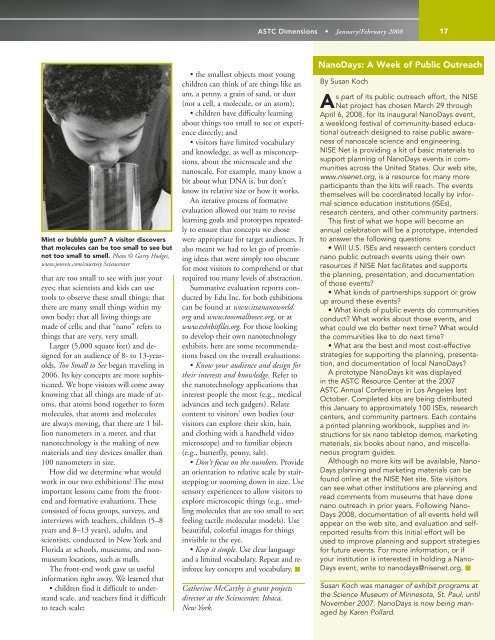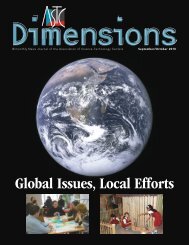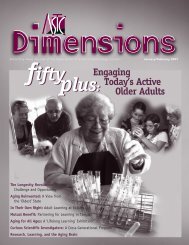Scientists Speak about Nano - Association of Science - Technology ...
Scientists Speak about Nano - Association of Science - Technology ...
Scientists Speak about Nano - Association of Science - Technology ...
You also want an ePaper? Increase the reach of your titles
YUMPU automatically turns print PDFs into web optimized ePapers that Google loves.
Mint or bubble gum? A visitor discovers<br />
that molecules can be too small to see but<br />
not too small to smell. Photo © Garry Hodges,<br />
www.jonreis.com/courtesy <strong>Science</strong>nter<br />
that are too small to see with just your<br />
eyes; that scientists and kids can use<br />
tools to observe these small things; that<br />
there are many small things within my<br />
own body; that all living things are<br />
made <strong>of</strong> cells; and that “nano” refers to<br />
things that are very, very small.<br />
Larger (5,000 square feet) and designed<br />
for an audience <strong>of</strong> 8- to 13-yearolds,<br />
Too Small to See began traveling in<br />
2006. Its key concepts are more sophisticated.<br />
We hope visitors will come away<br />
knowing that all things are made <strong>of</strong> atoms,<br />
that atoms bond together to form<br />
molecules, that atoms and molecules<br />
are always moving, that there are 1 billion<br />
nanometers in a meter, and that<br />
nanotechnology is the making <strong>of</strong> new<br />
materials and tiny devices smaller than<br />
100 nanometers in size.<br />
How did we determine what would<br />
work in our two exhibitions? The most<br />
important lessons came from the frontend<br />
and formative evaluations. These<br />
consisted <strong>of</strong> focus groups, surveys, and<br />
interviews with teachers, children (5–8<br />
years and 8–13 years), adults, and<br />
scientists, conducted in New York and<br />
Florida at schools, museums, and nonmuseum<br />
locations, such as malls.<br />
The front-end work gave us useful<br />
information right away. We learned that<br />
• children find it difficult to understand<br />
scale, and teachers find it difficult<br />
to teach scale;<br />
• the smallest objects most young<br />
children can think <strong>of</strong> are things like an<br />
ant, a penny, a grain <strong>of</strong> sand, or dust<br />
(not a cell, a molecule, or an atom);<br />
• children have difficulty learning<br />
<strong>about</strong> things too small to see or experience<br />
directly; and<br />
• visitors have limited vocabulary<br />
and knowledge, as well as misconceptions,<br />
<strong>about</strong> the microscale and the<br />
nanoscale. For example, many know a<br />
bit <strong>about</strong> what DNA is, but don’t<br />
know its relative size or how it works.<br />
An iterative process <strong>of</strong> formative<br />
evaluation allowed our team to revise<br />
learning goals and prototypes repeatedly<br />
to ensure that concepts we chose<br />
were appropriate for target audiences. It<br />
also meant we had to let go <strong>of</strong> promising<br />
ideas that were simply too obscure<br />
for most visitors to comprehend or that<br />
required too many levels <strong>of</strong> abstraction.<br />
Summative evaluation reports conducted<br />
by Edu Inc. for both exhibitions<br />
can be found at www.itsananoworld.<br />
org and www.toosmalltosee.org, or at<br />
www.exhibitfiles.org. For those looking<br />
to develop their own nanotechnology<br />
exhibits, here are some recommendations<br />
based on the overall evaluations:<br />
• Know your audience and design for<br />
their interests and knowledge. Refer to<br />
the nanotechnology applications that<br />
interest people the most (e.g., medical<br />
advances and tech gadgets). Relate<br />
content to visitors’ own bodies (our<br />
visitors can explore their skin, hair,<br />
and clothing with a handheld video<br />
microscope) and to familiar objects<br />
(e.g., butterfly, penny, salt).<br />
• Don’t focus on the numbers. Provide<br />
an orientation to relative scale by stairstepping<br />
or zooming down in size. Use<br />
sensory experiences to allow visitors to<br />
explore microscopic things (e.g., smelling<br />
molecules that are too small to see;<br />
feeling tactile molecular models). Use<br />
beautiful, colorful images for things<br />
invisible to the eye.<br />
• Keep it simple. Use clear language<br />
and a limited vocabulary. Repeat and reinforce<br />
key concepts and vocabulary. ■<br />
Catherine McCarthy is grant projects<br />
director at the <strong>Science</strong>nter, Ithaca,<br />
New York.<br />
ASTC Dimensions • January/February 2008 17<br />
<strong>Nano</strong>Days: A Week <strong>of</strong> Public Outreach<br />
By Susan Koch<br />
As part <strong>of</strong> its public outreach effort, the NISE<br />
Net project has chosen March 29 through<br />
April 6, 2008, for its inaugural <strong>Nano</strong>Days event,<br />
a weeklong festival <strong>of</strong> community-based educational<br />
outreach designed to raise public awareness<br />
<strong>of</strong> nanoscale science and engineering.<br />
NISE Net is providing a kit <strong>of</strong> basic materials to<br />
support planning <strong>of</strong> <strong>Nano</strong>Days events in communities<br />
across the United States. Our web site,<br />
www.nisenet.org, is a resource for many more<br />
participants than the kits will reach. The events<br />
themselves will be coordinated locally by informal<br />
science education institutions (ISEs),<br />
research centers, and other community partners.<br />
This first <strong>of</strong> what we hope will become an<br />
annual celebration will be a prototype, intended<br />
to answer the following questions:<br />
• Will U.S. ISEs and research centers conduct<br />
nano public outreach events using their own<br />
resources if NISE Net facilitates and supports<br />
the planning, presentation, and documentation<br />
<strong>of</strong> those events?<br />
• What kinds <strong>of</strong> partnerships support or grow<br />
up around these events?<br />
• What kinds <strong>of</strong> public events do communities<br />
conduct? What works <strong>about</strong> those events, and<br />
what could we do better next time? What would<br />
the communities like to do next time?<br />
• What are the best and most cost-effective<br />
strategies for supporting the planning, presentation,<br />
and documentation <strong>of</strong> local <strong>Nano</strong>Days?<br />
A prototype <strong>Nano</strong>Days kit was displayed<br />
in the ASTC Resource Center at the 2007<br />
ASTC Annual Conference in Los Angeles last<br />
October. Completed kits are being distributed<br />
this January to approximately 100 ISEs, research<br />
centers, and community partners. Each contains<br />
a printed planning workbook, supplies and instructions<br />
for six nano tabletop demos, marketing<br />
materials, six books <strong>about</strong> nano, and miscellaneous<br />
program guides.<br />
Although no more kits will be available, <strong>Nano</strong>-<br />
Days planning and marketing materials can be<br />
found online at the NISE Net site. Site visitors<br />
can see what other institutions are planning and<br />
read comments from museums that have done<br />
nano outreach in prior years. Following <strong>Nano</strong>-<br />
Days 2008, documentation <strong>of</strong> all events held will<br />
appear on the web site, and evaluation and selfreported<br />
results from this initial effort will be<br />
used to improve planning and support strategies<br />
for future events. For more information, or if<br />
your institution is interested in holding a <strong>Nano</strong>-<br />
Days event, write to nanodays@nisenet.org. ■<br />
Susan Koch was manager <strong>of</strong> exhibit programs at<br />
the <strong>Science</strong> Museum <strong>of</strong> Minnesota, St. Paul, until<br />
November 2007. <strong>Nano</strong>Days is now being managed<br />
by Karen Pollard.





